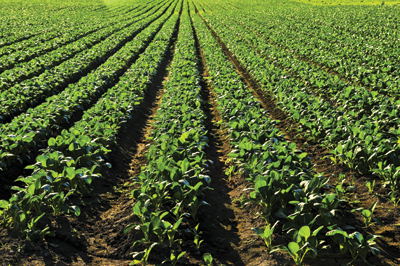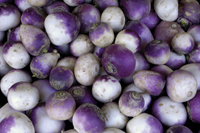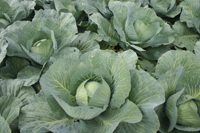
Features
Production
Research
Rotting vegetables in P.E.I. warehouses a concern
March 27, 2009 By Kathy Birt
Last summer’s wet weather in Prince Edward Island left some vegetable growers in a bind.
Heavy rains in August 2008 left fields and crops waterlogged and, over the winter season, some of those crops rotted in storage.
 |
|
| Willard Burke and his daughter, Crystal, of Fortune Bridge in eastern P.E.I., grew 280 acres of turnips, similar to these, and lost the entire crop.
|
Last summer’s wet weather in Prince Edward Island left some vegetable growers in a bind.
Heavy rains in August 2008 left fields and crops waterlogged and, over the winter season, some of those crops rotted in storage.
Environment Canada reported 20 days of rain in August 2008 in P.E.I., with a total of 223.8 mm of rain. This fell just four millimeters short of the all-time high recorded in July 1979 of 227.9 mm.
This wet weather did not allow for good growing conditions in a province where agriculture is the number one industry. In fact, some potato growers received compensation for leaving the worst hit crops in the field. As for other vegetable growers, some had minimal crop insurance while others had none. Hence, some crops were harvested “on a wing and a prayer.”
Gerald Dykerman of Brookfield Gardens, grows about 150 acres of carrots plus some cabbage, turnips, broccoli and cauliflower. He and his brother, Eddy, experienced a “little bit of a problem” with last season’s weather. The pair did not have crop insurance.

|
|
| The turnips had to be used as cattle feed after they went bad in storage. It’s uncertain whether the family will grow the crop again this season. |
|
 |
|
| The Burkes also had 10 acres of cabbage and 30 to 40 acres of carrots that ended up not being harvestable. The family will get some funds from crop insurance but it won’t be enough to cover the cost of growing the crops. |
Dykerman said there was about a 20 per cent yield reduction due to the heavy rains. He said some of these vegetables, such as cabbage, did not mature and were just left in the field.
Willard Burke and his daughter, Crystal, of Fortune Bridge in eastern P.E.I., did not fair as well as Brookfield Gardens. They grew 280 acres of turnips and lost the entire crop. The pile of rotting turnips that had been placed in their warehouse for winter storage had to be carted away by a neighbour to be used as cattle feed.
Crystal said they have local crop insurance and have also applied for compensation under Agriculture and Agri-Food Canada’s Agri-Recovery insurance program.
“Ottawa has to see that it was a disaster, but they haven’t done anything yet for vegetables growers,” she said. “They have for potato growers, but not other vegetable growers.”
She indicated she and her father will apply under the Agri-Stability program, but noted, “That’s not a cheque in your hand.”
The Burkes also had 10 acres of cabbage and 30 to 40 acres of carrots that ended up being mostly “not harvestable.”
Crystal said if they do get some funds from crop insurance, it wouldn’t cover the cost of growing the crops.
“We have no cash flow now and there is a lot of expenses involved with growing and harvesting,” she said. “As far as putting in another turnip crop, we’re not sure.”
The farm family has also been left with the added expense of cleaning and disinfecting their storage facilities.
“We’ll clean out the warehouses and probably get them disinfected,” Crystal said.
According to Stephanie MacDonald, Agriculture Innovation Officer with P.E.I.’s Department of Agriculture, it’s advisable for growers who are removing rotted vegetables to take precautions.
“After removing rotting vegetables, clean out all the organic matter, including all plant material,” she said, adding that all crevices should be cleaned out thoroughly. Once an area is cleaned out, a solution of chlorine bleach and water should be used to sanitize the warehouse, she said.
“It’s important to get the warehouse dried out during the summer months before more vegetables go in,” MacDonald said. “It’s just a good practice to clean every year anyway.”
Fungus can spread in many different conditions so “the drying is crucial,” she added.
For the next storage season, MacDonald said close monitoring of the crop in storage and quick removal of product showing early signs of spoilage could prevent losses.
“This could mean more frequent grading and marketing the crop earlier.”
She added that a cooling system can help to slow down the process of spoilage but “The cooling system won’t remove moisture. (Spoiling in) storage depends a lot on keeping a dry environment, good air circulation and minimizing the plant material going into storage with the vegetables,” she said.
Wayne MacKinnon, communications officer with P.E.I.’s Department of Agriculture, pointed out that most potato warehouses in the province are equipped with fans and cooling systems. He said this might have been advantageous to some growers in drying out waterlogged potatoes. “There are steps growers can take in drying down piles,” he said, but added there are limits to that.
And, even with these systems in place, losses can – and did – occur.
On P.E.I., crop losses varied, depending on which end of the Island a grower lived. According to David Aiton, a spokesperson with the P.E.I. Department of Agriculture, eastern growers either lost the crop or sold it off early to avoid spoilage in the warehouses. But they may have sold the crop at a loss, as the price of potatoes varied wildly in late 2008. Some growers may have sold their crops at about seven to eight cents a pound, while the price in December and January 2009 rose to 24 to 25 cents a pound.
It was a different story in the western end of the Island where less rain meant less loss. Potato growers in this area of the province were able to take advantage of a better market value for their crops.
Crop insurance
MacKinnon indicated that crop insurance payouts for 2008 are estimated to be one of the highest.
“Payouts could be as high as $20 to $30 million,” said MacKinnon.
Aiton noted that the 2008 growing season was disastrous. “We had unprecedented rainfall with unprecedented damage in the fields,” he said.
In the potato sector, Aiton said there was 91,000 acres grown on P.E.I. and 56,000 acres of that was covered by insurance. “So 62 per cent of the crop was underinsured,” he said, adding that if potato crops ended up being left in the field, crop insurance covered it. “Some took a gamble and transferred their losses from the field to the warehouse,” he said, noting that potato crops were also covered for storage losses.
Aiton indicated that 234,000 acres of crops, including grain, potatoes, and other vegetable crops, were insured across P.E.I. to a value of $136 million. He said most of the insurance claims had been paid out by the end of February. Payouts were expected to be about $25 million, Aiton noted. ❦
Print this page